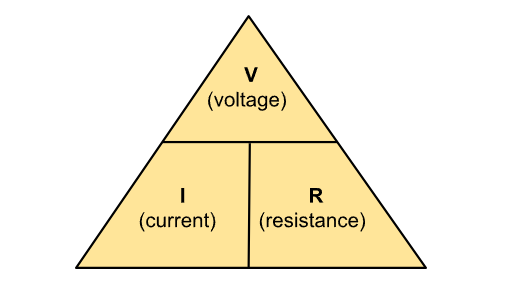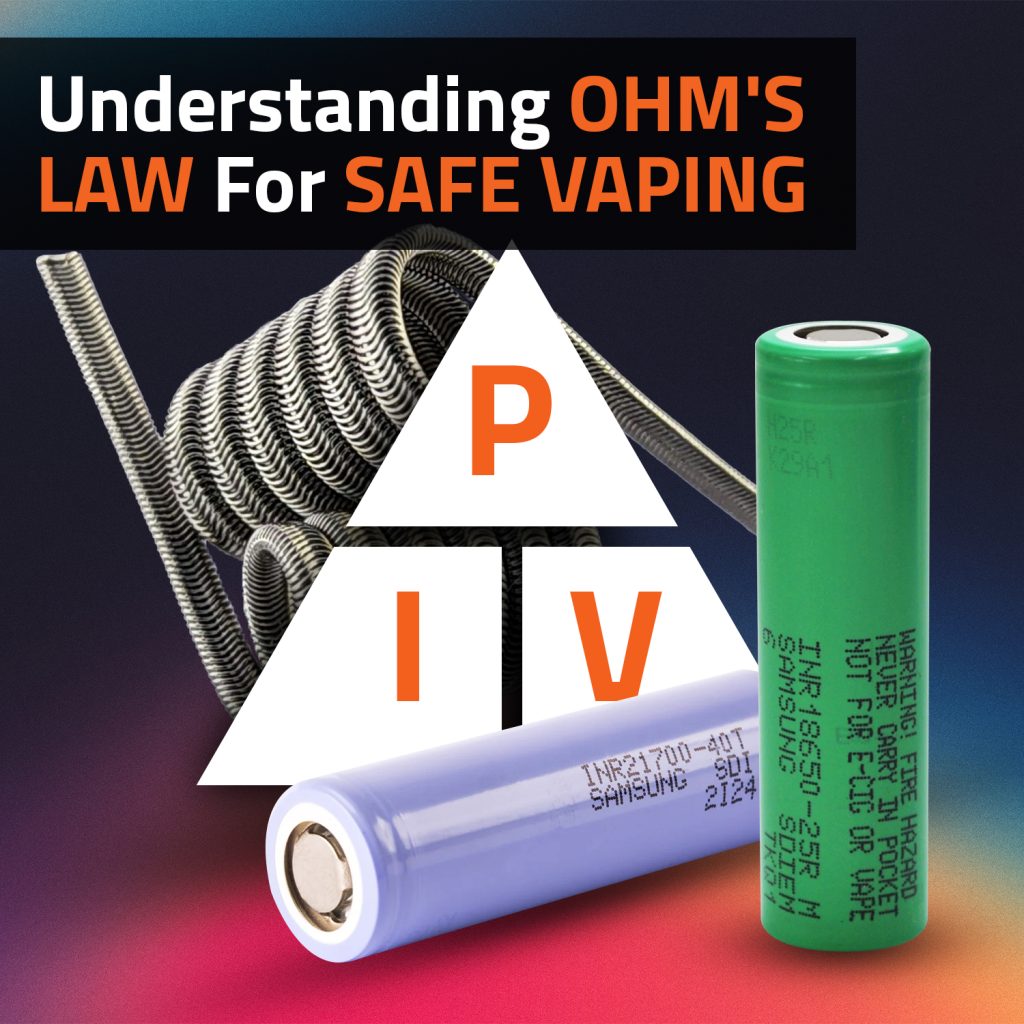Ohm’s Law is something that is at work in every vaping device, from the simplest disposable to the most complicated box mod. If you are into building your own coils, handling RDAs, and working with the more intricate side of vaping, you will need to have a thorough understanding of this concept to practise proper battery safety and get the vaping experience you want.
Although there are Ohm’s Law calculators out there that can be useful if you know how to use the values, having a general understanding of the formulas it entails will help you to understand your vaping device better and tailor your experience.
The Ohm’s Law Triangle
In simple terms, Ohm’s Law states that when the electrical resistance in your vaping device goes down, the power running through it goes up. With this information, we can calculate a few things.
There are three main elements in an electrical circuit, including voltage, current, and resistance. Their relationship is usually represented in a triangle as below:

The triangle can be read as “V divided by I multiplied by R.” To calculate any of the other values, you can just use some simple algebra to swap them around and change the symbols. But before we get to the maths, here is a little more clarification on what these letters refer to:
- V (voltage) – your battery voltage (the electrical potential)
- I (current) – the amperage your coil draws (like the “speed” of electricity running through your device)
- R (resistance) – the resistance of your coil (in ohms)
Calculating Current (I)
Calculating the current (I) is usually the most important value you want to focus on. This is due to the fact that the circuit of a vape kit comes with fixed V and R values. In other words, you will already know what batteries your device takes and which coils you are using.
The formula to determine the current drawn through your coil is: I = V ÷ R.
For example, if you were using a mechanical mod with a brand new battery and had 4.2 V of power available to your 0.5 Ω coil, you have everything you need to calculate your current:
- I = 4.2 V ÷ 0.5 Ω
- I = 8.4 Amps
Now that you have your current, you should check its amp limit to make sure you are staying in a safe range. If the device in the example has a 10 amp limit, that battery and coil combination is well below the safety limit.
If you are using a dual mechanical mod that is set up in a series configuration, you will have double the amp draw per battery. This means you will need to build coils that have double the resistance to vape safely.
It is also important to note that as your battery starts to deplete, the current gets weaker. If the battery in our example reaches 3.7 volts, the current will drop down to 7.4 amps.
Calculating Power/Wattage (P)
The next calculation is not represented in the triangle, but you will probably want to figure out how much power or wattage is generated at your coil. As for the formula: P = V x I.
In our original example, we would have:
- P = 4.2 x 8.4
- P = 35.3 Watts
You will notice that as the resistance of your coil increases, your wattage and current will both drop.
Calculating Resistance (R)
Calculating coil resistance is useful if you know your battery’s amp current limit and want to figure out what the lowest coil resistance is you can safely use without exceeding the battery’s continuous discharge rate (CDR): R = V ÷ I.
The device in the example has a CDR of 10 amps, so we will aim for 9 amps since it is always a good idea to give yourself some extra safe space. You also know your maximum voltage is 4.2 volts, giving you the following calculation:
- R = 4.2 V ÷ 9 A
- R = 0.47 Ω
The higher your current, the smaller your safe lower limit will be. If you use anything lower, you could exceed the CDR of the battery, causing it to overheat and cause damage.
Calculating Voltage (V)
The final calculation in the triangle is voltage: V = I x R.
You will most likely already have your voltage value when doing these calculations, so this part of the formula is not really as relevant to vapers, but it is good to know.
The Link Between Wattage And Amperage
Many vape kits include batteries that have an “mAh” value, which stands for milliamp hours. The amp hour value of your device is directly linked to the wattage your device operates at. One amp hour measurement is essentially how long a battery can provide 1 amp of power per hour.
Since vape kits allow you to adjust the output wattage of their electric circuit directly rather than adjusting the current flowing through it, it is better to use the known wattage value in your calculations.
To calculate your estimated battery runtime, use the following formula:
(10 x battery capacity in Ah) ÷ (appliance load in W)
For example, if you had a 3000 mAh battery, you would first switch it over to 3Ah. If you set your vape kit to a 30 W power output, you would calculate it as follows:
- Est. battery runtime = (10 x 3) ÷ 30
- Est. battery runtime = 1 hour
Therefore, your device will last 1 hour of vaping at that constant power output. Note you only actually access this power output while activating your device, so 1 hour is by no means a short lifespan.
That is essentially all you need to know about Ohm’s Law with regards to vaping! Now, you will easily be able to figure out what current your coil will draw and which wattage will be produced as a result. As resistance increases, current and power will decrease, and vice versa.
It is recommended that you use regulated mods for extra safety as a beginner since they have a built-in safety chip that breaks the circuit if the current in your device gets too strong. You should still stay within the safe settings range, though.
One last piece of advice: always work with the voltage value of your battery at full charge. Even if your coil might not stay at full battery voltage for a long period of time (or actually never gets there due to the natural voltage drop in the mod), this is just the best way to ensure proper battery safety.










